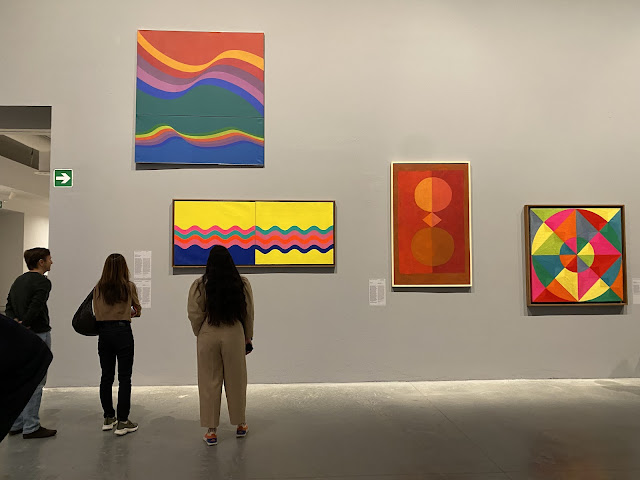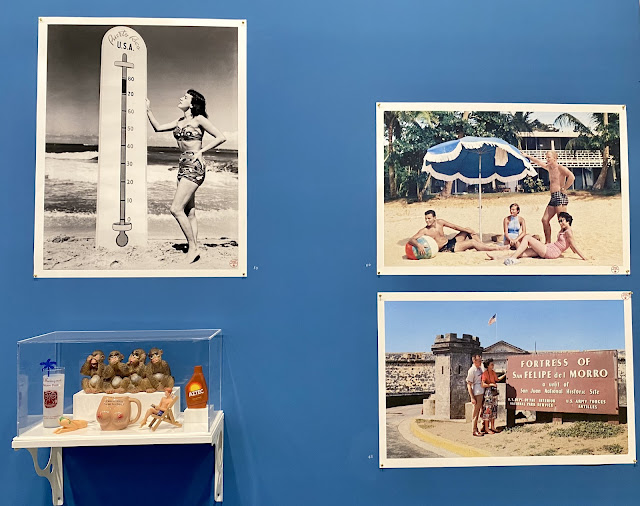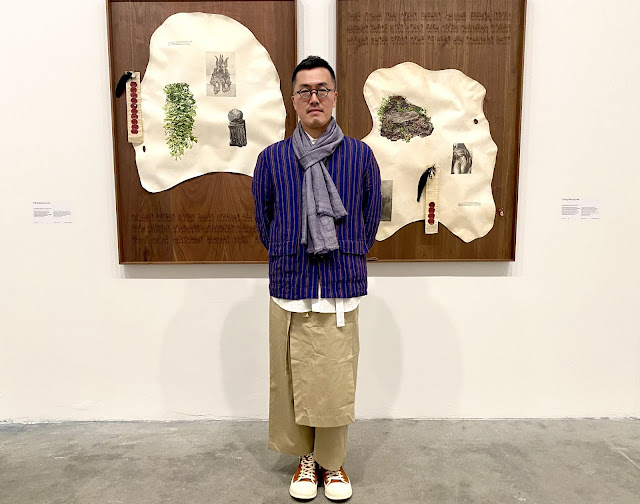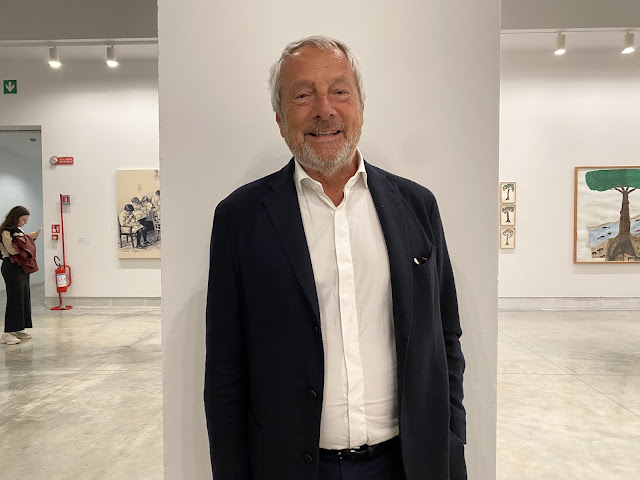"The expression Foreigners Everywhere has several meanings. First of all, that wherever you go and wherever you are you will always encounter foreigners— they/we are everywhere. Secondly, that no matter where you find yourself, you are always truly, and deep down inside, a foreigner."
Adriano Pedrosa
curator
Biennale Arte 2024 - Foreigners Everywhere
Central Pavilion - Giardini
The 60th International Art Exhibition, titled Stranieri Ovunque – Foreigners Everywhere - until November 24 - curated by Adriano Pedosa at the Giardini and the Arsenale; is curated by Adriano Pedrosa and organised by La Biennale di Venezia. The Exhibition takes place in the Central Pavilion - Giardini - and in the Arsenale - and presents two sections: the Nucleo Contemporaneo and the Nucleo Storico.
MAHKU - Movimento dos Artistas Huni Kuni
Mural - Facade - Central Pavilion
The title Stranieri Ovunque/Foreigners Everywhere is drawn from a series of works by Paris-born and Palermo-based Claire Fontaine Collective. According to dictionaries, the first meaning of the word “queer” is precisely “strange”, and thus the Exhibition unfolds and focuses on the production of other related subjects: the queer artist, who has moved within different sexualities and genders, often being persecuted or outlawed; the outsider artist, who is located at the margins of the art world, much like the self-taught artist, the folk artist and the artista popular; the indigenous artist, frequently treated as a foreigner in his or her own land. The productions of these four subjects are the interest of this Biennale, constituting the Nucleo Contemporaneo. Whilst the Nucleo Storico gathers works from 20th century Latin America, Africa, the Middle East and Asia.
Adriano Pedrosa - Curator - Brazil
currently the artistic director of Museu de Arte de São Paulo Assis Chateaubriand – MASP.
Immersed in a counter-artworld of activists and feminists throughout her youth, Nil Yalter - recipients of the Golden Lions for Lifetime Achievement - has been exhibited and celebrated within major institutions worldwide. The Nucleo Contemporaneo features two iconic works dealing with the theme of migration. Topak Ev - above - was made in reference to the tents made by Bektik nomadic community in Central Anatolia, traditionally made by brides-to-be and emblematic of gender roles in such communities.
Nil Yalter - Topak Ev - 1973
Exile is a Hard Job is named using the words of Turkish poet Nâzim Hikmet, features videos and fly-posters documenting the lives and experiences of immigrants and exiles, with the work’s title painted over them in bold red letters, in the manner of a political slogan.
Nil Yalter - Exile is a Hard Job - 1983-2024
Ione Saldanha’s Bambus are a radical way of pushing the boundaries between artistic languages, giving body and liveliness to painting. By appropriating an element from nature, the very organicity of the support claims its sculptural properties. The Bambus invite us to experience colour as we surround them. Hanging from the ceiling, they move subtly, like mobiles, evoking a playful and dynamic feel.
Ione Saldanha - Bambus - 1960s-70s
Mohamed Melehi - Composition - 1968
Mohamed Hamidi - Harmonie - 1969
Eduardo Terrazas - 1.1.91 - 1970-72
Pablo Delano is a visual artist and photographer with a keen interest in archives and the lives, histories, and struggles of Latin American and Caribbean communities. The installation’s title The Museum of Old Colony - 2024 - ironically references the complicity of museums and a US soft drink brand that is very popular in Puerto Rico, while highlighting how the power and presence of the US is grounded on colonial exploitation, social hygiene, and racial hierarchy in multiple ways, from the circulation of goods, peoples, and values to the recruitment of anthropologists, missionaries, photographers, and politicians in sustaining a colonial matrix.
The Museum of the Old Colony includes myriad objects, photographs, newspapers, films, and magazines from various sources that tell multiple stories related to Spanish and US domination over indigenous and native communities as well as people of African descent, picturing an intricately woven tapestry of Puerto Rico’s troubled histories.
Pablo Delano - The Museum of the Old Colony - 2024
Gaddafi in Rome: Anatomy of a Friendship - 2024 - is part of the research carried out by Alessandra Ferrini since 2017. The title refers to the - treaty of friendship, partnership, and cooperation between Italy and Libya - signed by the then heads of state Muammar Gaddafi and Silvio Berlusconi in 2008. These agreements were ratified during the Libyan leader’s visit to Rome in 2009. Starting from the iconicity of that encounter, the short film analyses the relationship between the two states, digging into the roots of the Italian occupation between 1911 and 1943 to arrive at the recent bilateral agreements that have redesigned migration policies in the Mediterranean.
Alessandra Ferrini - Geddafi in Rome: Anatomy of a Friendship - 2024
Massimiliano Gioni
curator - 55th - La Biennale di Venezia - Arte
Teresa Margolles - Human Imprint on Cloth - 2019
Bertina Lopes cultivated a distinctive body of work intimately intertwined with her political activism and social critique. Often blending formal and Constructive elements from European art circles with a visuality associated with the African continent, the artist transformed her canvas into a means of expressing freedom, both personally and in response to the repressive situation in her home country. These influences reinforce her sense of being a foreigner in Italy while maintaining a strong connection to her Mozambican heritage.
Bertina Lopes - Griddo Grand - 1970"I feel a slow and sure physical decay,
fanaticism of the mad love that has
torn everything from my body."
Aloise
Aloïse Corbaz spent most of her life in a Swiss psychiatric hospital, where she produced artwork characterised by a Surrealist notion of the infinitely revelatory nature of romantic passion, employing the rudimentary materials she had available, including toothpaste, thread, and juice from plants as well as coloured pencil and oil pastel. As in many of her works, female figures regaled in splendour or sensuous nakedness act as the protagonists.
Aloise - L'Angleterre - Trone de Dehli - 1960-63
Cecilia Alemani
Curator - 59th - La Biennale di Venezia - Arte
Maria Taniguchi - Untitled - 2023
Maria Taniguchi’s expansive painting project, spanning over a decade and a half, forms the foundation for her large, seemingly muted monochromes. The paintings presented at the Biennale Arte are part of Taniguchi’s larger project devoted to abstraction. These works exist in an ambiguous realm. Despite being painted surfaces, they take on the gravity of a sculpture as they recline against a wall, creating volume in their propped state.
Maria Taniguchi - Untitled - 2023
Kang Seung Lee engages in various artistic media including drawing, embroidery, installation, and appropriation of organic materials and objects. His work involves extensive research periods that are not just documentary but also integrate imagistic elements. Lee’s work is an installation based on the many narrative and iconographic possibilities of artistic figures who died due to AIDS-related complications. In the environment created by the artist, the spectator is able to reconfigure queer narratives in a transnational and transhistorical way.
Kang Seung Lee - Installation
Drawings, embroideries made with 24-karat gold-plated lines, objects hung from the ceiling, and other elements installed on the walls allow viewers to move between narratives that pay homage to essential names of queer culture in an anti-monumental way rather than an encyclopaedic narrative.
Kang Seung Lee - Installation - detail
Gabrielle Goliath’s immersive installations and performances examine frameworks of inequality and oppression, highlighting how these conditions may be transformed. Personal Accounts - 2024 - is an ongoing transnational project initiated in 2014. It employs video and sound to create installations that address the global normativity of patriarchal violence. The project records the testimonies of black, brown, indigenous, femme, queer, non-binary, and trans individuals. Each account unveils everyday structures that preserve patriarchal, racializing and colonial orders. These stories deal with violence and trauma. But they also shed light on the “creative and fugitive ways in which survivors assert life and possibility”, which she reframes as strategies for survival and repair.
Gabrielle Goliath - Personal Accounts - 2024
Superflex - Foreigners Please Don't Leave Us Alone With The Danes - poster - 2002
Louis Fratino is an artist whose paintings and drawings of the male body and domestic spaces capture the intimacy and tenderness found within everyday queer life. For Biennale Arte Fratino presents new paintings that explore the ways in which LGBTQ+ people are socialised to navigate the world as an “outsider”. This new body of work critiques the complexity of familial dynamics queer people face, beginning at childhood and continuing into adulthood. Drawing visual sources from the personal, Fratino juxtaposes the image of the family in contrast with visceral homoerotic imagery as a way to visually complicate the tensions between the two.
Louis Fratino - Eggs, Dishes, Coreopsis - 2020
A pioneering figure in Korean and Argentinian art, working in sculpture, painting, and printmaking, Kim Yun Shin has travelled extensively during her life, an experience which is deeply reflected in her work. At the Biennale Arte, Kim presents a group of eight sculptures. Conceptually, all of Kim’s works since the late 1970s possess the same title: Add Two Add One, Divide Two Divide One. Add and Divide are connected to Chinese philosophy’s Yin and Yang, which in turn represent multiple dichotomies and opposing concepts that are closely intertwined – two that are one, one that is two. Yin represents fragmentation, splitting, division, while Yang represents convergence, integration, addition.
Kim Yun Shin - Add Two Add One, Divide Two -1979
Aref el Rayess, a sculptor, painter, designer, and beloved father, was a prolific and eclectic Arab Modernist whose oeuvre spans the colonial, decolonial, and so-called postcolonial periods.
Aref El Rayess - Untitled - Deserts Series - 1988
Philomé Obin, like his younger brother Sénèque - below - is one of the creators of the Cap-Haitien school of painting, named for the commune on the north coast of Haiti. With a wide range of themes and a recognisable and influential style of complex narrative compositions, Obin is a chronicler of social dynamics in the public space.
Philome Obin - Missionaire - 1951
Sénèque Obin – part of a family of artists that included his older brother Philomé - above - he was in his fifties when he began painting and joined Port-au-Prince’s Centre d’Art. Obin’s practice as a painter and as an art activist offers a rich point of view from which to understand the arts in the Americas in the mid-twentieth century. His work exposes the contradictions of the modernisation process, challenging labels like “self- taught”, “naive”, and “primitive” often applied to artists of colour, like himself, which have prejudicially obscured the understanding of their complex works. With its precise lines, bold colours, and multiple narratives, the painting alludes to commerce, extraction, and the transformation of natural resources, evoked both in the commodities offered in the market and by the surrounding mountainous landscape in the background.
Seneque Obin - L'Union Fait la Force - 1954
André Taniki is a shaman born in the region of the Upper Catrimani river, in the Brazilian Amazon. His artistic output is directly linked to his association with artist and photographer Claudia Andujar and anthropologist Bruce Albert. These drawings were done in the late 1970s, in conversation with Bruce Albert, when both were searching for ways to depict shamanic visions. Lushly coloured, the drawings combine abstractions and figurative schemata in structures that seem to represent the organisation of the cosmos from the point of view of the Yanomamis’ sense-universe. Thus, they may be observed as a kind of cartography of that which is visible only to the xapiri – the Yanomami shaman’s auxiliary spirits – and to the shamans themselves. Both the circumstances in which they came to being as well as the drawings themselves stand as relevant expressions of the possibilities of translation and communication between different systems of knowledge and relations.
Andre Taniki Yanomami - Untitled 2 - 1978-81Abel Rodríguez was born in the Putumayo Department of Colombia and trained as a botanical expert amongst the Nonuya, one of several Amazonian ethnic groups. Sin título - above - is from a series that focuses on the taxonomical exploration of different varieties of Amazonian trees, capturing their distinct characteristics such as colour, leaf shape, trunk texture, and overall plant architecture. These meticulous depictions correspond to the specimen’s real-life characteristics and serve not only as compelling artistic representations, but also as scientifically accurate portrayals of Amazonian biodiversity.
Abel Rodriguez - Sin Titulo - 2023
President - La Biennale di Venezia - 2020-24
Aycoobo learned his craft empirically and through his father, renowned painter and plant expert Abel Rodríguez - see above - whose broad knowledge of the Amazonian landscape served as the foundations for elaborating on the worldview of the Nonuya people. The works presented in this exhibition address some of Aycoobo’s most pressing concerns: Calendario - below - is a drawing depicting a monthly calendar that associates the passage of time with the conditions of the Amazonian forests in each month of the year. It also represents the agricultural processes of the chagra - a part of the forest organically used for growing crops - as well as the underwater worlds and the centre of the earth. Together, all these works speak of what Aycoobo understands as a mandate: the transmission of knowledge and the creation of images that spring from a higher consciousness.
Aycoobo - Wilson Rodriguez - Naturaleza 2 - 2022

































